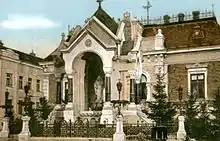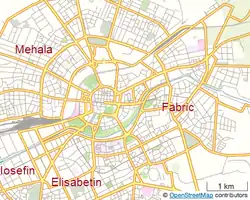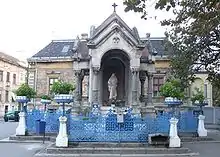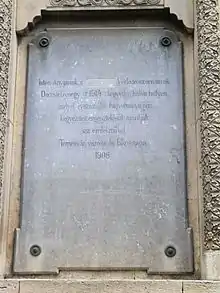Virgin Mary Monument, Timișoara
The Virgin Mary Monument is located in Timișoara, in Mary's Square and it has been there since 1906, when it was built on an older statue of Virgin Mary. The legend goes that György Dózsa has been executed there. The monument is a romanesque style canopy set on six pillars, under which lies the Statue of Mary, carved in Carrara marble.
| Monumentul Sfânta Maria din Piața Maria | |
 The monument în 1910, old postcard | |
 Virgin Mary Monument Location within Timișoara | |
| Coordinates | 45°44′53.89″N 21°13′7.82″E |
|---|---|
| Location | Timișoara, Romania |
| Designer | László Székely (architect), György Kiss (sculptor) |
| Type | memorial |
| Material | marble, granite, floor tiles, brick |
| Beginning date | 1906 |
| Completion date | 1906 |
| Dedicated to | György Dózsa |

The monument is situated in the historic Iosefin neighborhood. In 2012 it was suggested to be classified as a separate historical monument.[1]
History
Legend goes that during György Dózsa's execution, the Jesuits, who were chanting religious songs, saw Virgin Mary's figure in the smoke, which was considered a miracle. An icon of Virgin Mary was placed there, on a pillar, in a glass-framed box, to mark the event. It was kept there while Timișoara was occupied by the Turks (for 164 years) and long after that. After the liberation of the city in 1716, the Jesuits organized processions there.[2] The icon was accidentally broken by a carter who came to the fair.[3] Bishop Joseph Lonovics raised money to replace the icon with a wood-carved one. In 1865, this icon-statue was replaced with a Bavarian stone statue.[2][3] In 1877, the Notre Dame sisters School Sisters of Notre Dame (Banat) brought at their own expense a statue from the Mayer Institute in Munich.[2] At the beginning of the 20th century, the Timișoara City Hall decided to restore the monument. It was built in 1906 according to a project by László Székely[2][3] and the statue of Virgin Mary was completed by sculptor György Kiss.[3] The monument cost between 13,571 krones (about 4 kg of gold)[3] and 23,000 krones,[2] depending on the source asked. The inauguration was on 16 December 1906. Bishop József Németh, Mayor Carol Telbisz, prime-notary Joseph Geml, architect László Székely and sculptor György Kiss participated to the ceremony.
Description

The monument is a romanesque style chapel, with a floor tile canopy set on six pillars of Belgian granite with white marble capitals.[2]
The statue is made of Carrara marble[2] and it represents the Virgin Mary holding the Christ Child. The 1.55-meter-high statue stands on a pedestal.
The following inscription is written behind the chapel:
- "Isten Anyjának, a [magyarok] Védőasszonyának. Dózsa György (+1514.) kegyetlen halála helyén, melyet évszázadok hagyománya őriz, kegyeletes engesztelésül ajánlják ez emlékművet Temesvár városa és lakossága. 1906."[Note 1]
Destructions and restorations

After World War I, a first intervention was removing the word "Hungarians" from the inscription behind the monument. Lately there has been talk of redoing the original inscription.[3]
On the night between 11 and 12 January 2012, the statue has been vandalized, being knocked down from the pedestal and deteriorated.[4] The face was disfigured, the nose and mouth broken, as well as the hands. The Christ Child's face, shoulder and hand were broken, and some other details too.[5]
The restoration has been made between 12 March and 21 May 2012 by artist Ion Oprescu, specialist in stone restoration at Museum of Banat. Carrara marble has been used for the restoration. This included the chemical and manual cleaning, the execution of silicone rubber moulds for the damaged areas and the reconstruction of the missing or deteriorated areas by moulding and shaping, details which were integrated into the monument. The pedestal was also restored, the statue fixed on it and the whole monument preserved.[6][7] The restoration cost was of 30,000 lei. The restored statue was unveiled on 24 May 2012.[5]
Notes
- "To the Mother of God, protectress of the [Hungarians]. In the place of the cruel death of György Dózsa (+1514.) preserved by the tradition of centuries, this memorial is recommended for the pious atonement of Timișoara city and its population. 1906."
Footnotes
- (in Romanian) Lista monumentelor istorice clasate in grupa A sau grupa B din muncipiul Timisoara: D. Monumente propuse spre clasare prin PUG 2012, primariatm.ro. Retrieved 2016-07-02
- Nicolae Ilieșiu (1943). (in Romanian) Timișoara: monografie istorică, Timișoara: Planetarium, 3rd ed., ISBN 973-7836-92-8, pp. 317–318
- Stefan Both. (in Romanian) Minune în Piața Maria din Timișoara: a reapărut statuia Sfintei Fecioare Maria, adevarul.ro, 28 May 2012. Retrieved 2016-07-01
- Laliana Iedu. (in Romanian) Statuia din Piața Maria din Timișoara a fost vandalizată! Polițiștii au audiat un suspect, opiniatimisoarei.ro, 12 January 2012. Retrieved 2016-07-01
- Alina Strugariu. (in Romanian) Statuia vandalizată din Piața Maria a fost restaurată și va fi păzită, tion.ro, 24 May 2012. Retrieved 2016-07-01
- (in Romanian) Statuia Maria a fost redată timișorenilor, banaterra.eu, 24 May 2012. Retrieved 2016-07-01
- Alina Strugariu. (in Romanian) Statuia vandalizată din Piața Maria a fost restaurată, tion.ro, 23 May 2012. Retrieved 2016-07-01